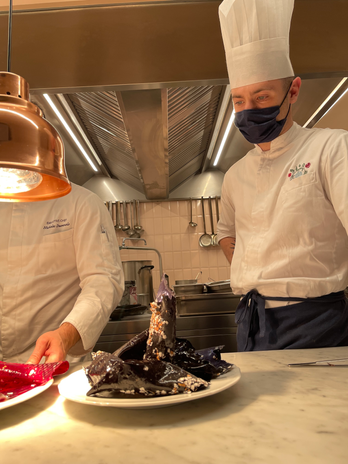A bioplastic is a type of plastic that can be made from plant starches or gelatins/agars. They are better for the environment because they are not derived from petroleum. They can also be easily made at home with a few simple ingredients and a stove.


BIOPLASTICS
We went to La Menangere, where we were allowed to experiment and learn about the elaboration of bioplastics in the kitchen.
NOTE: if you plan to laser cut your sample, it is important to remember not to add any plastic or acrylic to the sample as it will not be possible to cut it because it is toxic.
Also If you add plants, remember to check that they are very dry, otherwise your sample may mold.




RECIPIES
With AGAR or GELATIN
1. Gather the necessary materials. To make this type of bioplastic, you will need gelatin or agar powder, glycerol, hot water, a saucepan, a stove, a spatula, and a candy thermometer. These ingredients should be readily available at your local grocery store. Remember, glycerol is also known as glycerine, so look for that if you can’t find glycerol. You will need the following amounts of each ingredient:
-
3g (½ tsp) glycerol
-
12g (4 tsp) gelatin or agar
-
60ml (¼ cup) hot water
-
Food coloring (optional)
-
Agar is a substance derived from algae that can be used in place of gelatin to make the bioplastic vegan friendly
-
Photo frame
2. Stir together all of the ingredients. Combine all of the ingredients in the saucepan and stir until there are no clumps left. You may need to use a whisk to disperse all of the clumps. Place the saucepan on the stove and start heating the mixture on medium-high heat.
-
If you want to color your plastic, you can add a few drops of food coloring at this step.
3. Heat the mixture to 95°C (203°F) or until it begins to froth. Put the candy thermometer into the mixture and monitor the temperature until it reaches approximately 95°C (203°F) or begins to froth. If the mixture begins to froth before it reaches temperature, that is okay. Remove it from the heat when it either reaches temperature or starts frothing.
-
Continue to stir the mixture while it is heating up.
4. Pour mixture in a frame and leave to dry for 2 days.
With CORNSTARCH
1. Gather the necessary materials. To make this type of bioplastic, you will need cornstarch, distilled water, glycerol, a stove, a saucepan, a silicone spatula, and food coloring (if desired). These items should be readily available at the grocery store or online. Glycerol is also called glycerine, so try searching for that if you’re having trouble finding glycerol. The following amounts of each ingredient are needed to make the bioplastic:
-
10ml distilled water
-
0.5-1.5g glycerol
-
1.5g cornstarch
-
1-2 drops food coloring
-
Photo frame
2. Combine all of the ingredients and stir together. Add all of the ingredients to the saucepan and stir to combine with the spatula. Stir until you get rid of most of the lumps in the mixture. At this stage, the mixture will be a milky white color and quite watery.
-
If you add the wrong amounts of ingredients, just dispose of the mixture and start again.
3. Heat on medium-low. Place the saucepan on the stove and set the heat to medium-low. Stir continuously as the mixture heats. Bring it to a gentle boil. As the mixture heats, it will become more translucent and begin to thicken.
-
Remove the mixture from the heat when it becomes clear and thick.
-
Total heating time will be around 10-15 minutes.
-
Lumps may begin to form if the mixture gets overheated.
-
Add one-two drops of food coloring at this stage, if you would like to color the plastic.
4. Pour mixture in a frame and leave to dry for 2 days.








